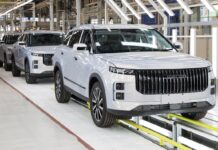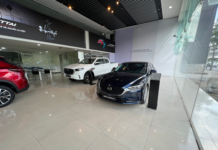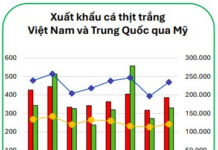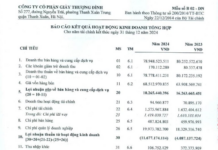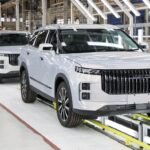In recent years, Vietnam’s automotive market has witnessed a significant shift as sedan sales (4-5 seater cars with low ground clearance) have plummeted, making way for high-clearance vehicles like SUVs and crossovers. Once the best-selling category, sedans now represent only a small fraction of total passenger car sales in the market.
Quietly Exiting the Game
In stark contrast to their golden era, many B-class sedans that once dominated the market, such as the Toyota Vios with annual sales of around 25,000 units, the Hyundai Accent with approximately 22,000 units, and the Honda City with nearly 15,000 units, have seen a sharp decline. These models were once the flagship, contributing up to 30% of total sales for their respective brands, but they no longer hold that position.

The D-class sedan Mazda 6 has been discontinued by dealerships for several months.
Statistics from the Vietnam Automobile Manufacturers’ Association (VAMA) reveal a steep decline: in 2022, the market sold 90,900 sedans, dropping to 52,000 in 2023, 47,000 in 2024, and only 30,446 units in the first 10 months of 2025. Projections for 2025 indicate a total of around 38,000 units, a further decrease of over 9,000 units compared to the previous year.
Among B-class sedans, the Mitsubishi Attrage sold only 1,456 units, the Toyota Vios 9,898 units, the Mazda 2 4,152 units, the Honda City 7,664 units, and the Kia Soluto a mere 237 units. The C-class sedan segment fared even worse, with the Kia K3 selling just 96 units, the Mazda 3 2,221 units, and the Honda Civic 388 units. D-class sedans, priced above 1 billion VND, also struggled: the Toyota Camry sold only 710 units in 10 months, the Kia K5 199 units, and the Honda Accord 32 units.
The lackluster market has led many sedan models to quietly exit the scene. For instance, the Suzuki Ciaz left the market without any announcement. Toyota also discontinued the Altis due to poor sales, replacing it with the Corolla, but sales remained sluggish, with only 208 units sold in 10 months. Ford previously discontinued the Fiesta and Focus models. Meanwhile, the Mazda 6, priced around 1 billion VND, disappeared from dealerships in September after selling only 56 units in the first 8 months of the year.
According to Mr. Trần Việt Nam, owner of an auto garage in An Khánh Ward (Ho Chi Minh City), the primary reason for the decline of sedans is the rise of SUVs and crossovers. “High-clearance vehicles are far more suitable for Vietnam’s road conditions, especially during the rainy season or in flooded areas. Their higher vantage point, flexible handling, and spacious interiors make them the top choice for families,” Mr. Nam explained.
Beyond their operational advantages, SUVs offer larger trunks, more amenities, and better suitability for travel, gradually eroding the practicality that once kept sedan sales high.
Prioritizing Convenience
According to Ms. Nguyễn Thị Hiền, owner of Hiền Auto System (Ho Chi Minh City), the biggest reason low-clearance cars are losing appeal is their insufficient ground clearance. This is a significant drawback in Vietnam’s traffic conditions. “Even moderate rain or high tides can cause sedans to flood, making them difficult to drive. Even navigating into apartment or shopping mall basements is less convenient compared to high-clearance vehicles,” Ms. Hiền noted.
Industry insiders observe that buyers now prioritize practicality for family use, such as spacious interiors, large trunks, clear visibility, and versatility across various terrains. These factors favor SUVs and crossovers. Meanwhile, the price gap between sedans and SUVs in the same segment is narrowing, making it easier for customers to upgrade to high-clearance vehicles. Many mid-range sedans are now priced similarly to or only slightly lower than entry-level SUVs.
Ms. Hiền added that before the COVID-19 pandemic, sedans accounted for 50%-60% of sales in the mainstream car segment. Many buyers purchased sedans for ride-hailing services. However, post-pandemic, this segment plummeted to just over 30% and has since fallen below 10%. “If current trends continue, sedans could account for only 5% of the market next year,” she predicted.
For C-class and D-class sedans, the reasons are clearer: their prices have surpassed 900 million VND, even exceeding 1 billion VND. For that amount, buyers can easily opt for an SUV with a sturdier design, higher ground clearance, and more spacious interiors. Ms. Lê Thanh Hải, General Director of Subaru Vietnam, admitted, “Billion-VND cars are now hard to sell. Conversely, models priced between 700-800 million VND are selling much better.”
Mr. Đào Minh Cường, sales manager at an auto showroom in An Đông Ward (Ho Chi Minh City), added that the rise of affordable electric vehicles has also contributed to buyers turning away from gasoline-powered sedans. “Many who bought sedans for ride-hailing services are now selling them off because they can’t compete with low-cost electric vehicles. Those planning to buy sedans for ride-hailing are quickly changing their minds,” Mr. Cường explained.
Electric Vehicles Dominate
The automotive market has recently seen an explosion in hybrid and electric vehicles with relatively “soft” prices, becoming a more attractive alternative to traditional sedans. Automakers are no longer heavily investing in sedans, maintaining them primarily for portfolio diversity while focusing resources on higher-performing SUVs.
The trend toward electrification further disadvantages sedans. New electric SUVs and crossovers are continuously launching, capturing significant market interest. Due to their underfloor battery placement, high-clearance electric vehicles are considered safer for navigating complex terrains. In contrast, electric sedans with low ground clearance raise concerns when driving over curbs, through flooded roads, or encountering potholes, as these conditions could damage the battery.
Imported Cars Surge Ahead of Domestically Assembled Vehicles: What’s Driving This Trend?
The October 2025 sales report, recently released by the Vietnam Automobile Manufacturers’ Association (VAMA), reveals a fascinating shift in the automotive market landscape.
The Hybrid Wave is Here: Toyota, Honda Announce Domestic Assembly, VinFast Set to Join the Race
Leading automakers such as Toyota and Honda are ramping up hybrid vehicle assembly in Vietnam, signaling a new race in the green transformation of the automotive industry.

